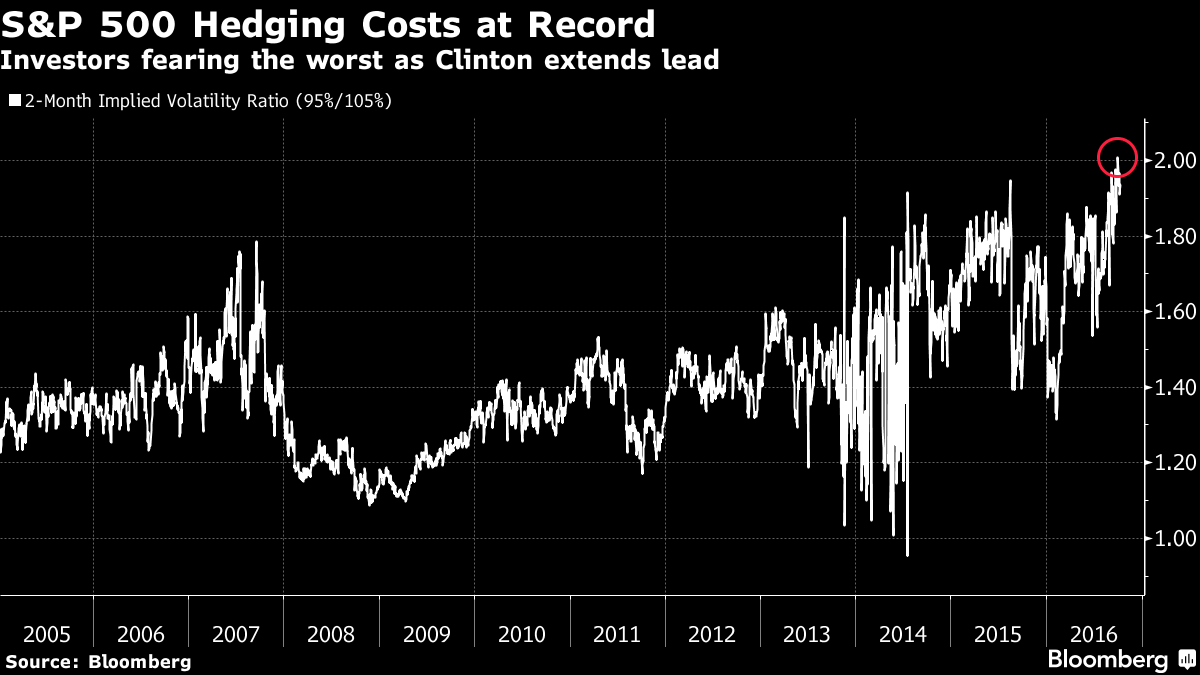Anxiety may have been hard to locate in the U.S. equity market before yesterday. But that didn’t mean it wasn’t there.
One measure of expected turbulence, the relative cost of options that pay when stocks decline versus those that appreciate when they rise, jumped to the highest level ever recorded just before the S&P 500 Index buckled on Tuesday. Call it the new normal for investors conditioned to expect the worst when it comes to politics, the economy and corporate earnings.
Even with Hillary Clinton taking her biggest lead in the polls since August versus Republican Donald Trump, the relative cost of hedging a 5 percent decline in an exchange-traded fund tracking the S&P 500 is twice the cost of betting on a gain, according to data compiled by Bloomberg. High readings in the indicator known as skew came even as the CBOE Volatility Index spent the previous three weeks trading below 14, on average.

Blame it partly on the experience of investors during the U.K.’s vote to leave the European Union, when weeks of calm was shattered by a political event and options worked in damping the resulting plunge. The market may be seeing its smallest fluctuations in more than a year, but traders remain on alert for events that could whip up declines.
“If there’s a potential shock to the system when you have low volatility, that boosts skew,” Matt Friedman, senior vice president of options trading at Convergex in New York, said by phone. “Investors are bracing for potential downside risk, regardless of how likely it is. At the same time, you’re seeing people dismiss the potential upside.”
The S&P 500 was little changed at 2,137.15 at 9:58 a.m, while the CBOE Volatility Index rose 4.6 percent.
Frequent Upheavals
Upheavals that shatter prevailing calm in equities are becoming more frequent. Markets were shocked out of one of the longest stretches of tranquility ever recorded last month when $600 billion was erased from the value of shares on Sept. 9. In the last two years there have been five similarly extreme shifts in volatility -- as many as occurred in the prior two decades, according to data complied by Deutsche Bank AG and Bloomberg.
The Deutsche Bank study examined instances of rapid mood transitions in U.S. equities, counting times when realized volatility in the S&P 500 surged from a very low level, below 10, to above 20 within six weeks. On that basis, the market has seen its prevailing calm broken five times since 2014, matching the total in the preceding 20 years -- a stretch that encompasses two full-blown bear markets.
At the same time, tools for hedging stocks or betting on declines are proliferating. Trading in exchange-traded funds and notes tied to the VIX has gone from nothing a decade ago to hundreds of millions of shares a day. The iPath S&P 500 VIX Short-Term Futures ETN recorded more volume on Sept. 13 than any company in the S&P 500, with a record 110 million shares changing hands.








